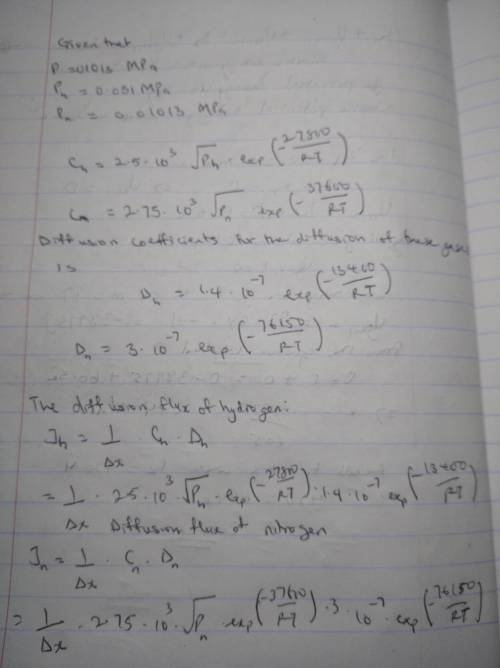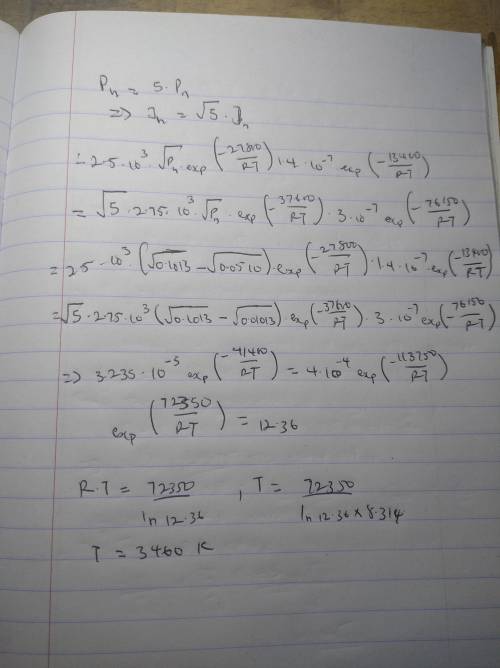
Engineering, 20.10.2020 20:01 angelinaranee15
It is desired to enrich the partial pressure of hydrogen in a hydrogen–nitrogen gas mixture for which the partial pressures of both gases are 0.1013 MPa (1 atm). It has been proposed to accomplish this by passing both gases through a thin sheet of some metal at an elevated temperature; in as much as hydrogen diffuses through the plate at a higher rate than does nitrogen, the partial pressure of hydrogen will be higher on the exit side of the sheet. The design calls for partial pressures of 0.051 MPa (0.5 atm) and 0.01013 MPa (0.1 atm), respectively, for hydrogen and nitrogen. The concentrations of hydrogen and nitrogen (CHC
H and CNC N , in mol/m3mol/m
3 ) in this metal are functions of gas partial pressures (pH2 and pN2p
H 2 and p N , in MPa) and absolute temperature and are given by the following expressions:
CH=2.5×103√pH2exp(−27,800J/mol/RT)
CN=2.75×103√pN2exp(−37,600J/mol/RT )
Furthermore, the diffusion coefficients for the diffusion of these gases in this metal are functions of the absolute temperature, as follows:
DH(m2/s)=1.4×10−7exp(−13,400J/mol/R T)
DN(m2/s)=3.0×10−7exp(−76,150J/mol/R T)
Is it possible to purify hydrogen gas in this manner? If so, specify a temperature at which the process may be carried out, and also the thickness of metal sheet that would be required. If this procedure is not possible, then state the reason(s) why.

Answers: 2
Another question on Engineering

Engineering, 03.07.2019 23:20
Two technicians are discussing the intake air temperature (iat) sensor. technician a says that the computer uses the iat sensor as a backup to the engine coolant temperature (ect) sensor. technician b says that the powertrain control module (pcm) will subtract the calculated amount of fuel if the air measures hot. who is correct
Answers: 3

Engineering, 04.07.2019 18:10
Courses that are developed by subject matter experts, internal or extemal to the college or university. these programs are marketed by the school (clo2) marks a)-vocational schools b)-vendor training c)-colleges & universities d)-continuing education programs
Answers: 2


Engineering, 04.07.2019 19:20
Acommercial grade cubical freezer, 4 m on a side, has a composite wall consisting of an exterior sheet of 5.0-mm thick plain carbon steel (kst= 60.5 w/m k), an intermediate layer of 100-mm thick polyurethane insulation (kins 0.02 w/m k), and an inner sheet of 5.0- mm thick aluminium alloy (kal polyurethane insulation and both metallic sheets are each characterized by a thermal contact resistance of r 2.5 x 104 m2 k/w. (a) what is the steady-state cooling load that must be maintained by the refrigerator under conditions for which the outer and inner surface temperatures are 25°c and -5°c, respectively? (b) for power saving purpose, which wall material should be increased/reduced in. thickness in order to reduce 50% of the cooling load found in part (a)? redesign the thickness of the proposed material. 177 w/m-k). adhesive interfaces between the q=575.93 w
Answers: 2
You know the right answer?
It is desired to enrich the partial pressure of hydrogen in a hydrogen–nitrogen gas mixture for whic...
Questions





Social Studies, 07.01.2020 01:31


Social Studies, 07.01.2020 01:31


Mathematics, 07.01.2020 01:31





English, 07.01.2020 01:31


Social Studies, 07.01.2020 01:31



Social Studies, 07.01.2020 01:31





